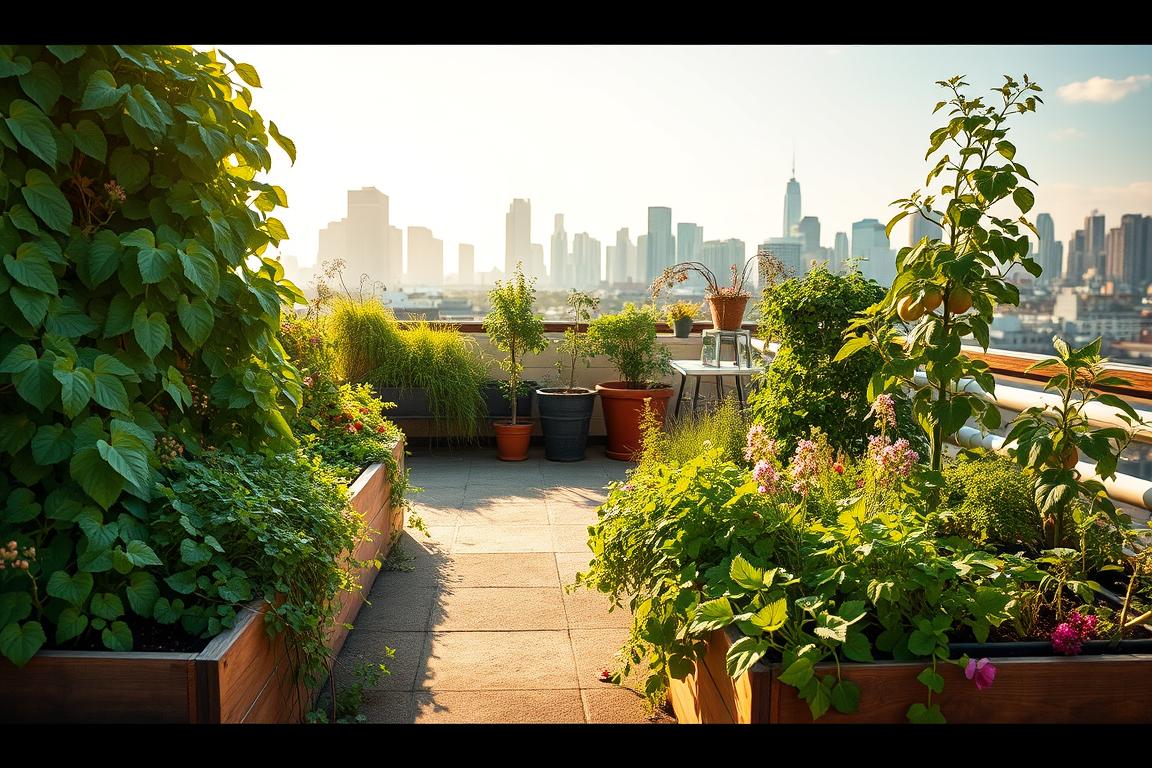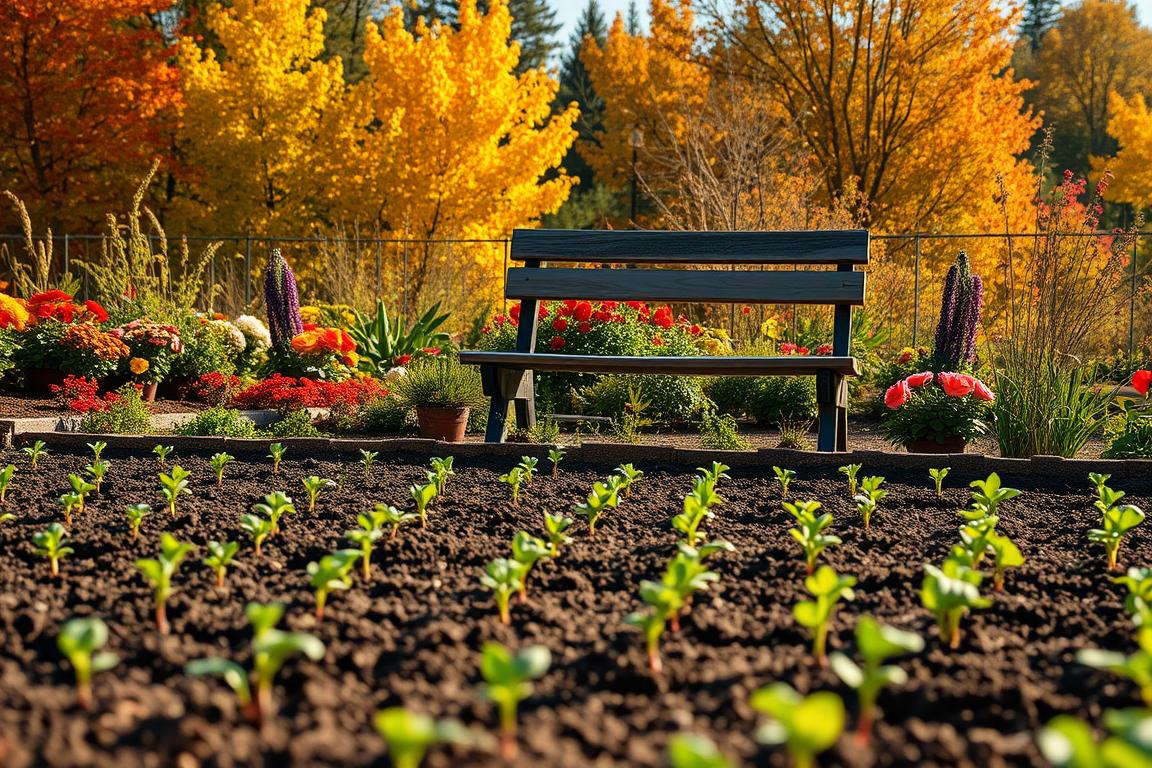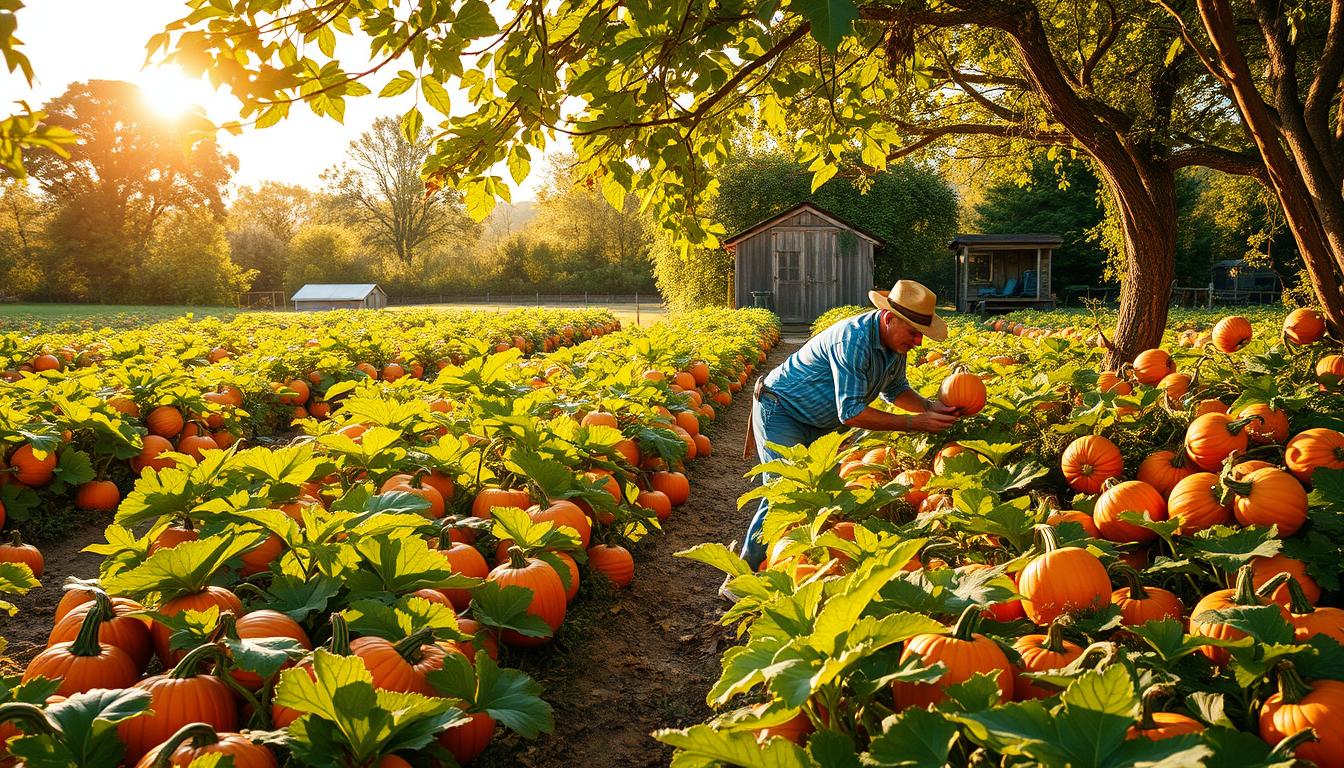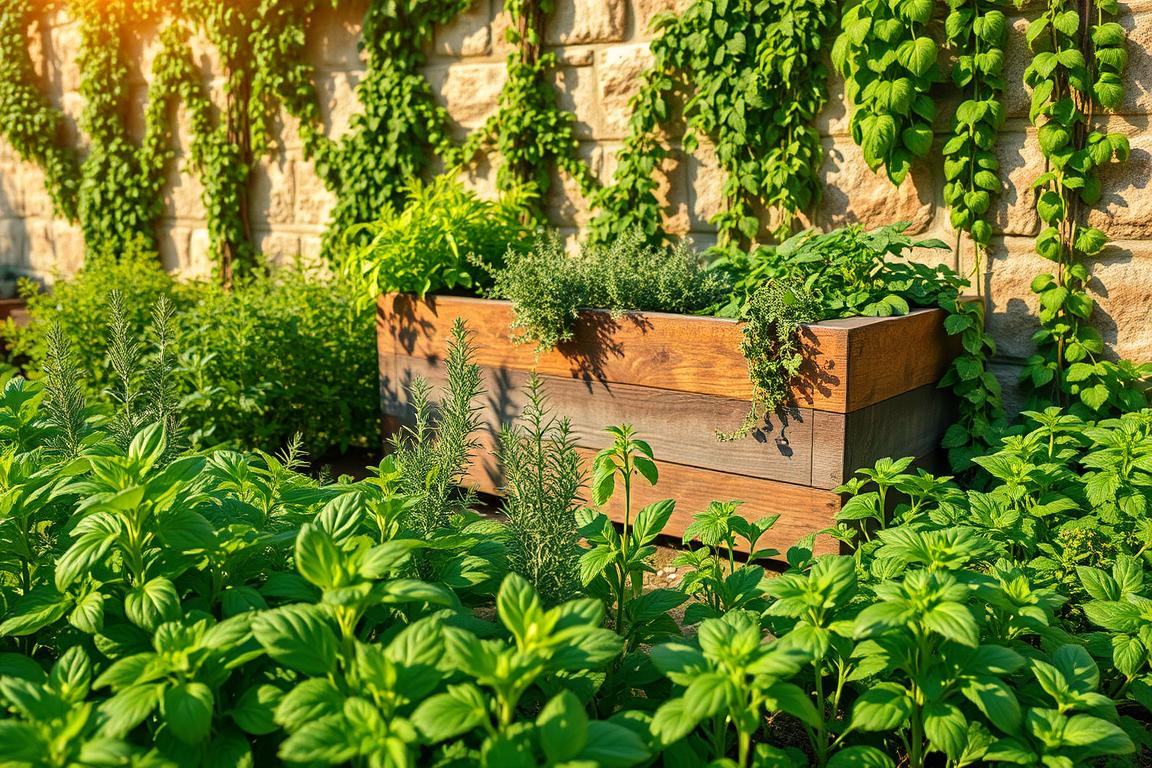I’ve always been amazed by urban gardening. It can turn even the smallest areas into green, productive spots. Whether you have a tiny balcony or a small patio, you can still garden.
Compact gardening lets you grow many plants in small garden ideas. The Spruce says micro gardening is great for small spaces. It’s rewarding and doable.
With creative gardening, any small area can become a lush garden. This makes your space better and gives you fresh food right at home.
Key Takeaways
- Urban gardening can be done in limited spaces like balconies or patios.
- Compact gardening techniques maximize space usage.
- Micro gardening is a viable option for growing various plants.
- Creative strategies can turn small areas into thriving gardens.
- Gardening in small spaces can provide fresh produce.
The Art of Small Space Gardening
Creating a garden in a small space needs careful planning. You must understand the challenges and opportunities it offers. Success comes from knowing your space, the light, and setting achievable goals.
Assessing Your Available Space
Start by measuring your space. Note any obstacles like drainage pipes or power lines. Think about how to use your space wisely.
Use a simple table to organize your space:
| Space Characteristics | Measurements | Notes |
|---|---|---|
| Width | 5 feet | Potential for a narrow herb garden |
| Length | 8 feet | Ideal for a series of containers |
| Sunlight Exposure | Partial Shade | Best for shade-tolerant plants |
Understanding Light and Microclimate Conditions
Light is key in gardening. Know the light in your space. Watch it throughout the day. Also, think about the microclimate, like temperature and wind, to pick the right plants.
Setting Realistic Goals for Your Mini Garden
Setting goals is crucial for a successful garden. Decide what you want from your garden. It could be growing herbs, creating a peaceful spot, or adding greenery. Clear goals help you design your garden and enjoy the journey.
By taking these steps, you’re on your way to a beautiful small space garden. It will bring joy and peace to your life.
Essential Techniques for Limited Spaces
Small space gardening is all about using smart techniques to grow a great garden. You need to know and use several key methods to make the most of your space.
Vertical Gardening Solutions
Vertical gardening is a top choice for small spaces. It grows plants up using supports like trellises or wall systems. This method saves space and adds beauty to your garden. Vertical gardening can boost yields and free up the floor for other uses.
For example, using a trellis for climbing plants like peas or beans can really help your garden grow.
Container Gardening Fundamentals
Container gardening is another great way for small spaces. It lets you grow many plants in pots or tubs.
Choosing the Right Containers
Picking the right container is key. It should be big enough for the plant’s roots and have holes for water to drain. Terracotta pots are popular because they breathe well and look good.
Proper Soil Mixtures for Containers
The soil in containers should drain well and be full of nutrients. A mix made for containers has peat, vermiculite, and perlite. This soil holds moisture but also drains excess water, preventing root rot.
Square Foot and Intensive Planting Methods
Square foot gardening divides your bed into 1×1 foot sections. Each section grows a different crop. This method uses space well and cuts down on waste. It’s great for growing many vegetables and herbs in a small area.
Utilizing Hanging and Wall-Mounted Gardens
Hanging baskets and wall gardens are great for extra space. Hanging baskets are good for flowers, herbs, or strawberries. Wall gardens work for many plants, like leafy greens and succulents. These options save space and look nice.
Designing Gardens for Specific Small Spaces
Creating a garden in a small space needs careful planning. It’s important to know the special needs of your area. Whether it’s a balcony, patio, courtyard, or indoor spot, understanding its challenges and benefits is crucial.
Balcony Garden Layouts
Balcony gardens face unique hurdles like weight limits and wind. It’s vital to think about these when designing. This ensures your garden is safe and flourishes.
Patio and Courtyard Garden Designs
Patio and courtyard gardens have more room to play with. But, they still need a good plan. Think about your furniture layout and how it affects gardening space. Use container gardening to make your garden flexible and easy to change.
According to
The Spruce
, these gardens can be both useful and beautiful. Mix plants, hardscaping, and decor to achieve this.
| Garden Type | Key Considerations | Design Ideas |
|---|---|---|
| Balcony Garden | Weight, wind protection | Use lightweight containers, windbreaks |
| Patio/Courtyard Garden | Layout, furniture placement | Container gardening, mix of plants and hardscaping |
| Indoor Garden | Light, temperature | Use grow lights, temperature-controlled spaces |
Windowsill and Indoor Garden Solutions
Indoor gardening is great for small spaces. Think about your plants’ light needs. Use grow lights if needed. Windowsills are perfect for sun-loving plants, while low-light spots can have low-light plants.
By understanding your space and using the right design, you can make a beautiful garden. It will enhance your living area.
Best Plants for Small Space Gardening
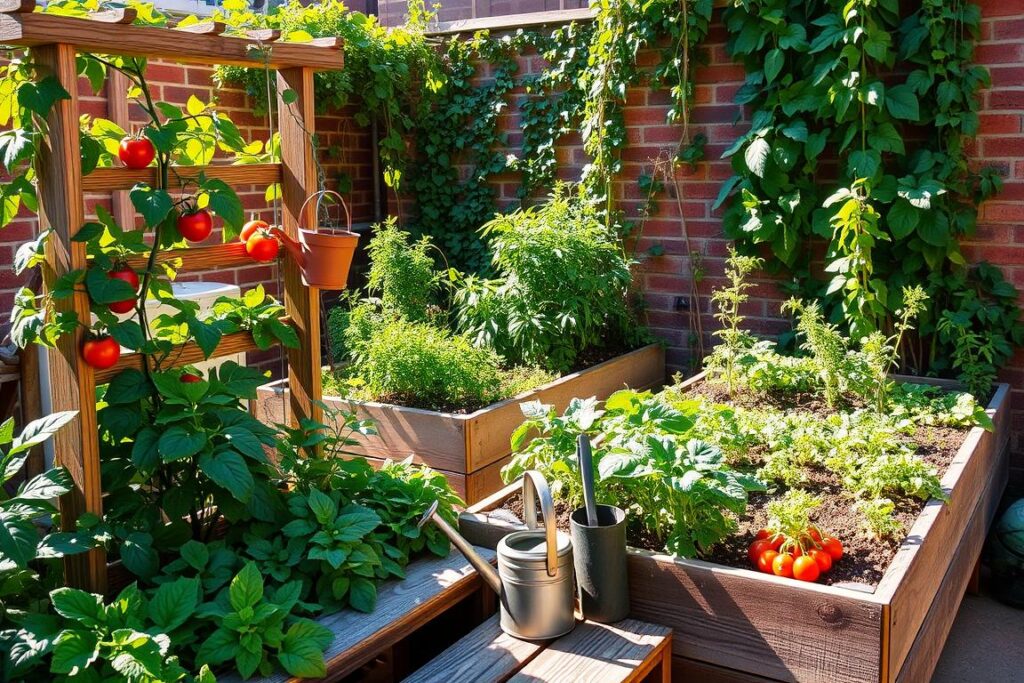
To make the most of small space gardening, it’s key to choose the right plants. The right plants can grow well in tight spaces, giving you a lot of food and beauty. We’ll look at some top picks for small gardens, like space-saving veggies, compact herbs, small fruit trees, and plants that do it all.
Space-Efficient Vegetables and Microgreens
For a small space vegetable garden, pick plants that grow small or can climb up. Leafy greens, cherry tomatoes, and peppers are great. Microgreens are young, packed with nutrients, and ready to eat in just 1-3 weeks. They need little space and can grow on windowsills or in small pots.
Compact Herbs for Cooking and Aromatics
Herbs are key in any garden, and there are many compact herbs for small spots. Basil, mint, cilantro, and parsley are favorites that grow well in pots or small areas. They taste great in food and smell wonderful. Use hanging baskets or wall planters to save space.
Dwarf Fruit Varieties and Berry Plants
Dwarf fruit varieties are perfect for small gardens. They grow big fruit without needing a lot of room. Try dwarf apple, citrus, and stone fruit trees. Berry plants like strawberries, blueberries, and raspberries also work well in small spaces, especially in pots or hanging baskets.
Multi-Purpose and Ornamental Plants
Adding multi-purpose and ornamental plants to your small garden makes it more interesting and useful. Plants like nasturtiums, calendulas, and violas are tasty and colorful. Other plants can offer shade, keep pests away, or attract good bugs.
Conclusion: Embracing the Small Garden Lifestyle
Small space gardening shows us that even tiny areas can bloom into beautiful gardens. By using space-saving gardening techniques, you can turn any small spot into a green paradise. Whether it’s a balcony, patio, or tiny backyard, there are many small garden ideas to spark your creativity.
Exploring balcony garden ideas, apartment gardening, and small backyard gardening opens up a world of possibilities. With the right plants, vertical gardening, and smart gardening methods, you can harvest plenty and enjoy the gardening benefits. So, begin planning your small garden today and find the happiness in growing your own green space.
FAQ
Q: What is small space gardening, and how can I get started?
A: Small space gardening means growing plants in small areas like balconies or indoor spaces. First, check how much space you have. Then, understand the light and climate conditions. Lastly, set goals for what you want to grow.
Q: What are the best techniques for gardening in small spaces?
A: Good techniques include vertical gardening, container gardening, and intensive planting. These methods help you use your space well. You can grow many types of plants, like veggies, herbs, and flowers.
Q: How do I choose the right containers for my small space garden?
A: Choose containers based on size, material, and drainage. Pick ones that are 5-7 gallons to give roots room. Make sure they have holes for water to drain.
Q: What are some space-efficient vegetables and microgreens for small space gardening?
A: Great choices include leafy greens, cherry tomatoes, and microgreens like arugula and radish. These plants are small, grow fast, and can be picked in 1-3 weeks.
Q: Can I grow herbs in small spaces, and which varieties are best?
A: Yes, many herbs do well in small spaces. Compact herbs like basil, mint, and parsley are good. They grow easily and can be picked often to keep them growing.
Q: How can I protect my balcony garden from wind and extreme weather conditions?
A: Use screens or trellises as windbreaks. Secure containers and plants to avoid damage. Bring plants inside or use a frost blanket during bad weather.
Q: What are some design ideas for patio and courtyard gardens?
A: For patio or courtyard gardens, think about layout, lighting, and furniture. Mix containers, raised beds, and vertical gardening for a layered look.
Q: Can I grow fruit trees in small spaces, and which varieties are suitable?
A: Yes, you can grow dwarf fruit trees like citrus, apple, and fig in small spaces. Look for varieties that are compact or bred for small gardens.
Q: How can I care for my indoor plants and keep them healthy?
A: Keep indoor plants healthy by giving them the right light, water, and nutrients. Use a good potting mix and fertilize often. Also, check the temperature and humidity to keep it right for your plants.


